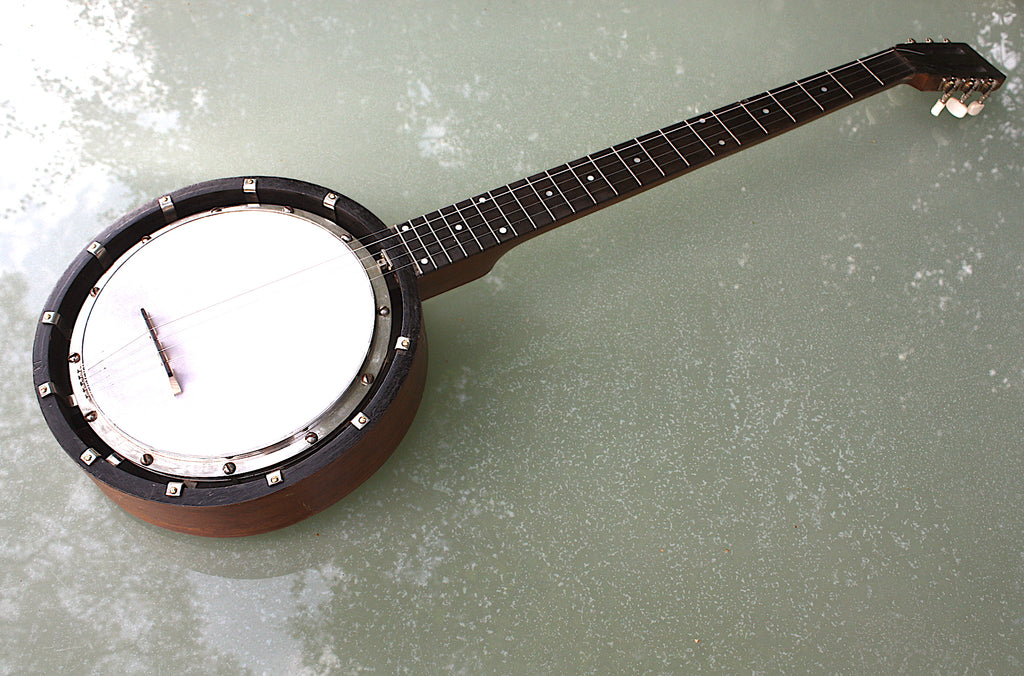5 string banjo refurb

I don't get involved with banjos that often , but I've made a few, replaced torn skins and restored an Appalachian style mountain banjo that belonged to Neil Young, so I know my way round the basics.
Here's one that came in last week - it's an old English "zither" banjo - why on earth they call them that I don't know, as it's got nothing to do with any zither that I've seen. Anyhow, it had been picked up cheap, it's probably around 100 years old, the skin was torn and it was unplayable. The plus point was that it had all of it's hardware, and it had the stamp "John Alvey Turner - London". I Googled it, and surprise surprise, the company is still in existence!
First job was to take it apart so that I could get the skin off and replace it. I cleaned up the pot, the rim and fixing brackets, and fitted a new head. It's not that hard - these old banjos don't have pre-formed skin mounted on a ring, you have to soak the skin in water and wrap it round a metal hoop, mount it onto the flange and tension ring and let it dry overnight. At all looked OK, although it needed a little fettling to replace a missing pearl dot, re-mount the machineheads (which are non-original), plug holes and replace missing and mis-matching screws, trim the fret ends, polish the frets and condition the fretboard. It was obvious that the instrument had been fixed-up and tinkered with several times.

When I put it together it was obvious that the action was totally unplayable, and I'd need to re-set the neck angle, which required quite bit of work to the dowel stick and neck heel to put a bit of angle onto the neck. This was very time consuming, as I had to put it together and take it part about ten times, before determining that it was about right. A fresh set of d'Addario strings and deepening the nut slots got it playable, so here it is.

These old English made banjos can make a decent starter instrument - they are often for sale cheap online or at car boot sales, but there are a few eccentricities and points to watch out for. There are usually fairly well made, but each maker seemed to do things their own way, so don't expect modern banjo hardware to fit. It's therefore import to make sure that there are no vital parts missing, particularly the rim tension brackets and fittings, as replacements are sometimes impossible to find. It's almost inevitable that it will need a new vellum (calfskin head), but they are readily available and it's not that difficult to learn how to fit one. Machineheads are a bit of a lottery - this one originally had sets of 3 on a plate, but had newer individual ones fitted. The post holes were on a different spacing to modern ones, so I couldn't fit a replacement set of modern 3 on a plate, and had to re-use the ones that came with it, drilling out a broken fixing screw and plugging the original screw holes. Talking of machineheads, take a look at the photo - 6 machineheads, it's a six string, right? No, wrong.
It's a 5 string and they just left one of the tuners unused - this was a very common approach amongst English makers. Also look how the 5th drone G string is mounted - there's no peg at the 5th fret, but the string is tunnelled under the fretboard through a little brass tube, and emerges at the headstock. This was a typical English way of doing it, so watch out for this if you are scouting round for one.
So there you go, a 100 year old instrument back in action, after a bit of care and attention.
- John Wormald



Comments 2
Chickenbone John
Any decent brand of 5 string banjo strings will be fine, such as a d’Addario , Ernie Ball, Rotosound, GHS etc. The most common tuning is G D G B D (low to high) , approximate gauges 10, 24w,15, 13 10 (low to high) -hope that helps.
Mario BLACKWELL
Thank you for this article
I’ve just been gifted one very similar but more pearl
It all seems ok and will start cleaning it tomorrow
Could you give me advice on strings and tuning
Thank you
Mario
07790454726